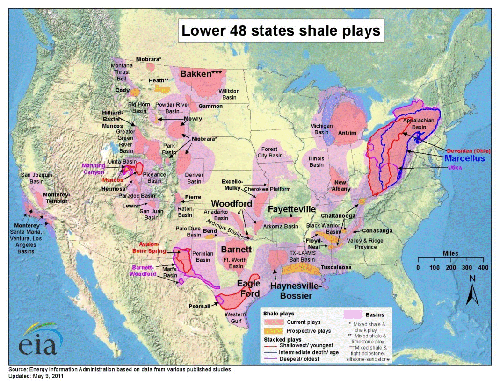Oil and gas shales in North America have been known for decades, but most investors don't know it exists or what is produced from each play. This is a shame because we could be at the beginning stages of an oil and gas renaissance in the United States, as we are beginning to meet some of our energy needs. The ability to obtain resources from unconventional targets has opened new investment opportunities. This is important as the U.S. is increasing oil production faster than anywhere in the world, and looks to have decade's worth of locations to drill. From a natural gas standpoint, the U.S. has increased supply significantly. Due to the increased supply T. Boone Pickens refers to the U.S. as the Saudi Arabia of natural gas. Natural gas prices have collapsed since the natural gas boom, and producers are currently slowing its 2012 programs. Due to the difficulty in transporting natural gas, prices are region specific, but oil and natural gas liquids (NGLs) are a different story. Liquids can be pipelined to refineries, but due to a lack of capacity in Cushing, Oklahoma Bakken Crude prices sell at a discount to West Texas Intermediate (WTI). WTI sells at a discount to Brent Crude, which is generally the term used for crude from the Middle East and the North Sea. When the pipeline to the Gulf is completed Brent/WTI differentials should tighten. Quality has nothing to do with the difference in pricing of these three types of oil. If this was the case, Bakken oil would be the most expensive as it is the lightest crude when compared to WTI and Brent. It is a supply/demand issue, based on an influx of oil from Canada and the mid-continent of the U.S. Without adequate transports for these liquids supply outstrips demand and pushes prices lower. Light Louisiana Sweet (LLS) sells for a significant premium to WTI, which has caused some oil producers to rail oil to collect better pricing.
Unconventional oil plays have come at a good time as the U.S. has seen production drop significantly since 1985 at 11.1 million barrels per day. Oil production steadily declined to 8.3 million barrels per day in 2005, but production in 2010 had increased to 9.6 million barrels per day. Oil shale is the reason for this increase. Oil-bearing shale is an oil-rich rock containing a significant amount of kerogen. All shale differs in mineral content, thickness, chemical composition, etc. This is one of the reasons every well seems to produce differently, but this can also be different based on the operator or completion methods. The largest deposits in the world are in the Green River Formation, which is located in Colorado, Utah and Wyoming. The U.S. has 62% of the world's oil shale reserves. In 2005, the world's total oil shale resource was set at the equivalent of 2.8 to 3.3 trillion barrels of shale oil. The number and size of these plays are quite large. Some plays are already producing while others are still in the exploratory phase.
In the early 1980s, no one thought these shales would be commercial. Much of the tests run on shales were vertical wells, drilled to depth and then fracked. Because the wells were vertical, only a small percentage of the shale had contact, so results were poor. Directional drilling changed this, as a vertical well will be drilled to the depth of the shale and drilled to length. These methods increased well contact from 5,000 to 10,000 feet, depending on the length of the lateral. Hydraulic fracturing or "fracking" can be very effective in horizontal wells. Up to 6 million gallons of water, sand, proppant and chemicals are injected into the well at a high pressure. This causes the shale to crack or fracture. The sand and proppant "prop" open the fractures and hold it open to keep oil moving into the lateral. Geosteering allows for steering or adjusting the angle of drilling without stopping. Significant improvements were seen in unconventional wells when this was coupled with 3D seismic. Swell Packers, sliding sleeves and other technologies have all been very important to accelerating the development of North American shale plays.
As seen below, the U.S. is littered with oil and gas shale plays.
SEE: Oil And Gas Industry Primer
Guide To Oil And Gas Plays In North America: Shale
Unconventional oil plays have come at a good time as the U.S. has seen production drop significantly since 1985 at 11.1 million barrels per day. Oil production steadily declined to 8.3 million barrels per day in 2005, but production in 2010 had increased to 9.6 million barrels per day. Oil shale is the reason for this increase. Oil-bearing shale is an oil-rich rock containing a significant amount of kerogen. All shale differs in mineral content, thickness, chemical composition, etc. This is one of the reasons every well seems to produce differently, but this can also be different based on the operator or completion methods. The largest deposits in the world are in the Green River Formation, which is located in Colorado, Utah and Wyoming. The U.S. has 62% of the world's oil shale reserves. In 2005, the world's total oil shale resource was set at the equivalent of 2.8 to 3.3 trillion barrels of shale oil. The number and size of these plays are quite large. Some plays are already producing while others are still in the exploratory phase.
In the early 1980s, no one thought these shales would be commercial. Much of the tests run on shales were vertical wells, drilled to depth and then fracked. Because the wells were vertical, only a small percentage of the shale had contact, so results were poor. Directional drilling changed this, as a vertical well will be drilled to the depth of the shale and drilled to length. These methods increased well contact from 5,000 to 10,000 feet, depending on the length of the lateral. Hydraulic fracturing or "fracking" can be very effective in horizontal wells. Up to 6 million gallons of water, sand, proppant and chemicals are injected into the well at a high pressure. This causes the shale to crack or fracture. The sand and proppant "prop" open the fractures and hold it open to keep oil moving into the lateral. Geosteering allows for steering or adjusting the angle of drilling without stopping. Significant improvements were seen in unconventional wells when this was coupled with 3D seismic. Swell Packers, sliding sleeves and other technologies have all been very important to accelerating the development of North American shale plays.
As seen below, the U.S. is littered with oil and gas shale plays.
 |
| Figure 1: Shale gas plays in the lower 48 states. |
| Image: Energy Information Administration |
SEE: Oil And Gas Industry Primer
Guide To Oil And Gas Plays In North America: Shale
Related Articles
-
 Investing
InvestingShale Oil vs. Oil Shale: What's the Difference?
Discover the biggest difference between oil shale and shale oil, and which one is still a money-making proposition. -
 Investing
InvestingU.S. Shale Oil Production: The Rise and Fall
Low oil prices are taking their toll on U.S. shale oil producers, but their rise over the last decade is evidence of increasing U.S. energy independence. -
 Investing
InvestingThe 3 Best ETFs to Bet On
Three ETF strategies and corresponding ETFs to bet on a rebound for U.S. shale oil, including indirect plays, hedging and focused exposure strategies. -
 Financial Advisor
Financial AdvisorWhat Happened to Oil Prices in 2017
Oil has made headlines for its plummeting price action in 2016, with experts saying a rebound was due in 2017. After a sharp drop, it rebounded strongly. -
 Investing
InvestingShould U.S. Producers Shut Down While Oil Is out of the Money?
Should oil producers simply stop producing and wait for oil prices to recover? It may make sense for some producers to shut down in a $40 per barrel oil price environment. -
 Investing
InvestingHow Low Can Oil Prices Go?
Record low oil prices are a welcome development for consumers, but oil companies are struggling with choosing market share over profitability. -
 Insights
InsightsWho Wins With Low Energy Prices?
Low oil prices are here to stay for some time. Which economies will benefit or lose from the low oil price regime? -
 Investing
InvestingTop 6 Oil-Producing States
Check out the U.S. states that produce the most barrels of crude oil each year. -
 Investing
InvestingDo Natural Gas Prices Always Follow Oil Trends?
Prices for oil and natural gas are highly correlated. But investors should be aware of different factors affecting the prices of these commodities.



